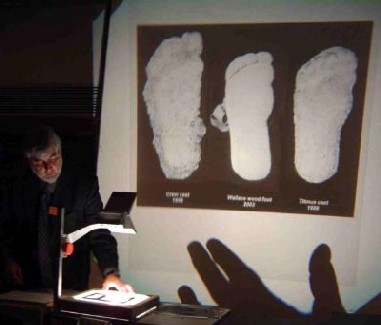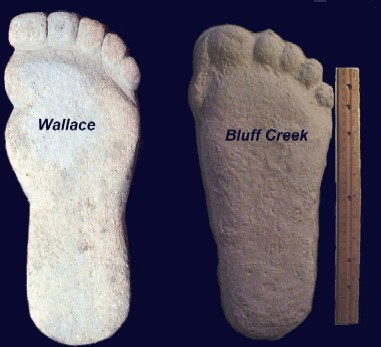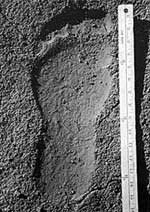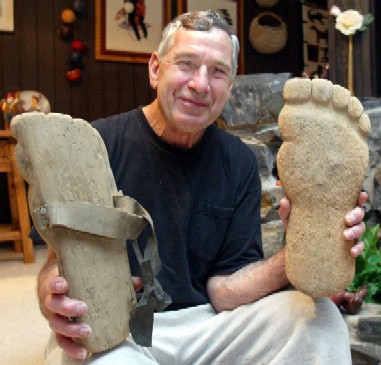Remove Ray Wallace’s Fake Photos
Posted by: Loren Coleman on May 27th, 2006

Ray Wallace lives on. Memorial Day weekend is a good time to reflect on the ones that have passed along, and notice their impact. Positively and negatively. It is also a time to renew the cry to remove the bad data, remove the fakery in our midst, remove the Wallace fake track photos from the Bigfoot books out there.
Less than a month ago, another overview article in another Pacific Northwest newspaper decided to talk about Wallace:
The best known local Bigfoot trickster was the late Ray Wallace, a Toledo man whose family said helped create the Bigfoot legend.
In 1958, Wallace made giant footprints at a work site in Humboldt County, Calif., that were reported by a local newspaper the next day.
Wallace continued Bigfoot pranks when he returned to Washington, even having his wife dress up as one of the half-human wilderness creatures, relatives said.
But Ray Crowe of the International Bigfoot Society in Hillsboro, Ore., said Wallace was a true believer and pulled some of the pranks to throw critics off the track.
Of course, Ray Wallace didn’t create "the Bigfoot legend," and I won’t exactly say he "helped" it along either.
The Bluff Creek incidents of 1958 involved two different kinds of footprints, and that simple fact appears to still escape journalists five years after Wallace’s death.
The evidence to this is in plaster and wood, so obviously demonstrated below.

Beyond the obvious above, however, maybe Ray Crowe is correct on a level overlooked by modern Bigfooters. Isn’t Ray Wallace able to still throw people off the "track" because his fakes continue to populate the pages of so many new books on the subject?
Unfortunately, the imprints left by the Wallace fakes still haunt us in the uncritical photographs in newly published and old reprints of Sasquatch books. These "perfect footprints" are held up as actual evidence of a real creature passing that way. But indeed, the Wallace pranks continued on around the Blue Creek-Bluff Creek area throughout the 1960s.

Today, it seems, Bigfoot researchers are confronted with a future full of Wallace fakes in several new books. These recycled texts hide old sins, and serve to distract with an incorrect database, as so many of these prints continue to be uncritically labeled as "real." It seems that if some pieces of evidence deserve astericks in revised volumes, surely these “tracks” – probable Wallace fakes – do.
Memorial Day Weekend is a good time to reflect, while it rains outside, or after a long day of outdoor activities, on how we can move on from the death of Wallace. Begin the process. Thumb through your Sasquatch books. Take the steps to a more critically-aware cryptozoological future: Acknowledge the fakes, remove them, and promote the best evidence.

Compare the Ray Wallace fake wooden carved foot, on the right, with the photograph of an alleged "real" Bigfoot footprint found in many books, above. The Wallace creation would have been worn and pressed in fine dirt – thus its reverse image was left. Rubert photo, used by permission.
About Loren Coleman
Loren Coleman is one of the world’s leading cryptozoologists, some say “the” leading living cryptozoologist. Certainly, he is acknowledged as the current living American researcher and writer who has most popularized cryptozoology in the late 20th and early 21st centuries.
Starting his fieldwork and investigations in 1960, after traveling and trekking extensively in pursuit of cryptozoological mysteries, Coleman began writing to share his experiences in 1969. An honorary member of Ivan T. Sanderson’s Society for the Investigation of the Unexplained in the 1970s, Coleman has been bestowed with similar honorary memberships of the North Idaho College Cryptozoology Club in 1983, and in subsequent years, that of the British Columbia Scientific Cryptozoology Club, CryptoSafari International, and other international organizations. He was also a Life Member and Benefactor of the International Society of Cryptozoology (now-defunct).
Loren Coleman’s daily blog, as a member of the Cryptomundo Team, served as an ongoing avenue of communication for the ever-growing body of cryptozoo news from 2005 through 2013. He returned as an infrequent contributor beginning Halloween week of 2015.
Coleman is the founder in 2003, and current director of the International Cryptozoology Museum in Portland, Maine.










If Wallace was a true believer, was his reason for making fake tracks, keeping people interested in the subject?
We agree it is certainly time to move beyond all the gibberish generated in the early days of BF activities, but we would NEVER actually cut photos, text or ANYTHING, no matter what their nature, from the pages of books!
Books, to us, are sacrosanct logs, the text and tales, the information and images contained in them giving mute testimony to one tiny part of a subject, at one tiny point in time.
I would and have, however, appended photos and text blocks (in our own library only) with a red felt-tip pen, when that material has later been PROVEN to be bogus, even correcting dimensions and other data in an otherwise accurate item.
Future readers are kinda depending on us, the books’ current owners, to pass along that data, especially in this crypto-research arena, in as correctly informative and comprehensive a manner as possible.
So. Just as passing along a well-researched and written opus for future edification is proper, so too is the careful annotating of gross errors and mistakes ~ in our opinion.
But not cutting!
(We don’t even fold over a page corner to mark our place ~ physical damage starts the slippery slope to dog-eared obscurity, and ruins the book for posterity!)
Is there a reason you are called “Fuzzy”? LOL.
Either you are joking or you are a concrete thinker of the first degree.
The discussion here was about the revision and updating of future texts to acknowledge the Wallace fakes for what they are, and to move them to the “hoax” section of an updated book being reprinted. Or when a new book is produced, to critically think about what you are showing as “evidence” of the possible reality of Bigfoot via footprints.
I do not advocate cutting books up, ripping pages out, marking within books, or x-ing out photographs.
The books out there remain as they are. But please note, many books have been revised, reprinted, and mass distributed since Wallace’s death that contain, uncritically, obvious photos of fake footprints that match his wooden creations. There’s no reason for this to continue.
This posting has nothing to do with the destruction of books.
Huh? Guess I misunderstood your “remove the Wallace fake track photos from the Bigfoot books out there” and “Thumb through your Sasquatch books… acknowledge the fakes, remove them, and promote the best evidence” admonishment.
“Fuzzy” relates to my long curly hair and beard.
Loren, you are right. It is time to note the fakes, and put the real evidence in the spot light.
Nothing is indelible or infallible. Whether it is traditional science or the false claims of hucksters. It was in the competitively recent past that empirical science did not acknowledge, officially, that rocks fell from the sky.
Being a recognized scientific expert with the baggage of exclusivity, of theoretical truth like a franchise, to be defended as capable of producing funding like a golden goose, is a slippery slope.
One error can be fatal. The same applies to fakes, scoundrels, fools and lunatics.
They have a short shelf life in history.
Most folks like myself are underestimated in that, yes, we do recognize there is no straight line to the truth. It has to be bought with dead ends, detours, pitfalls and self-deception. What is authorative, gospel, and written in stone is a moving target. That applies to both sides of the fence between self aggrandizement and being skeptical of ones own assumptions. Buyer beware.
I can see the need for republishing books and all with updated and correct information. In my true field of expertise mmisinformation and un-corrected bad information has done considerable damage – some which may not be possible to repair
One of the problems is that when a new book is written, among the main sources of information are old books, and too often material is just incorporated uncritically. It is the author’s resposibility to review all old material if the field is to evolve, and this is true for any subject.
jayman. I believe that is what Loren means
It’s good general advice, but in the specific instance, if you are writing a book and remove the material from Blue Creek, you’ll be in agreement with Loren but in disagreement with John Green. The issue hasn’t been resolved among the “experts”. So far as I can see, it’s not going to be resolved either. While the one track from Blue Creek that Loren uses *does* look very much like Wallace’s fake, Rick Noll showed that it was not a direct match. So you can’t say that you know it was a fake, all you can say is that it looks like one and then hypothesize that Wallace at one time had a different version of his fake foot and used it at Blue Creek. Even with that you’ve got problems, because Loren’s only been able to show a similarity in one photograph (a similarity that doesn’t hold up to measurement, remember). He doesn’t make much of the fact that there were hundreds of prints found at the location made by different sized feet in several substrates. As Rick Noll pointed out on a now famous BFF thread, some of those foot impressions can’t be explained by our present understanding of Wallace’s hoaxing method. If Wallace used wooden feet, he’d have had to have had dozens of them, swapping them out between steps. He’d have had to have some way of getting his wooden feet up and down embankments while maintaining a natural look. There are quite a few reasons to suppose that the footprints at Blue Creek aren’t hoaxed, and it appears the only reason to think they are is that one of them looks fake. And it *does* look fake. The preponderence of the evidence suggests that it probably isn’t.
Any new text should, instead of making a pronouncement one way or another, put out both sides of the argument as succinctly as possible.
Of course, I basically agree with dbdonlon, as I am all for showing both sides, all sides, in these book examinations. That is rarely done, and there has been no shift in most entrenched positions despite the things that we supposedly have learned from the Wallace fakes.
Too many people are still blind to the fact Wallace did actually leave his prank tracks within the broader context of real prints, in a few instances. The position is, if you accept any Wallace pranking, then, someway, you are acknowledging that he faked everything. That’s as silly as saying that what I am discussing should be totally ignored.
Bigfoot research is not about blacks and whites.
The postings here about the Wallace fakes, of course, have only touched the surface. Both sides have debated this for some time, in earlier Cryptomundo blogs, on forums, and in emails. But the evidence is, of course, more than one isolated photograph of one track within one trackway. The Wallace-fakes can be found through the books, if people merely open their eyes.
While the supporters of the Blue Creek tracks, those that wish to retain them in the database, seem to sound like they have made a valid rebuttal, upon closer examination, they have often flipped left for right, measured incorrectly, and done so with a comparison of the wrong Wallace fake tool. This has been dealt with elsewhere, but if it needs to be re-aired here, again, perhaps that’s something to think about for the summer.
Loren you are correct with your last post. I agree all sides need to be given their due so as the reader can form his own conclusions on the subject.
The phoneys only make the real (Patty) look better. Keep the fakes! I’m amazed at how some people think hoaxing bigfoot is easy. Only an idiot would put Pattersons film and Wallaces (among others)on the same plane. Without the contrast it all becomes theory instead of study of actual realities inherant in morphology/physiology, locomotion, mass/wieght-physics etc.